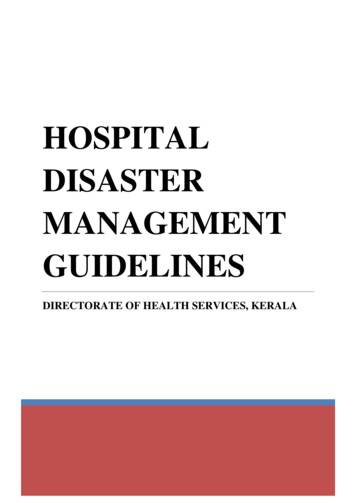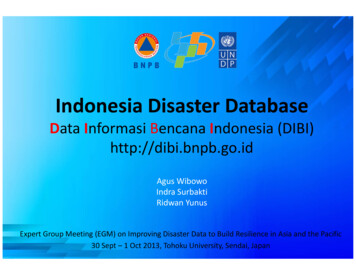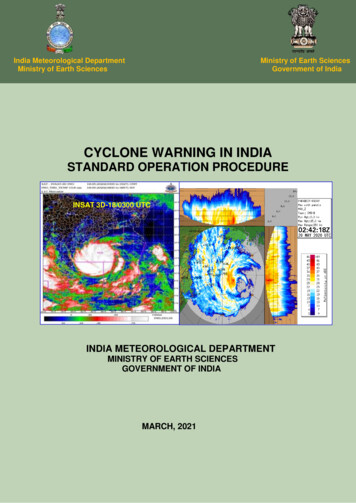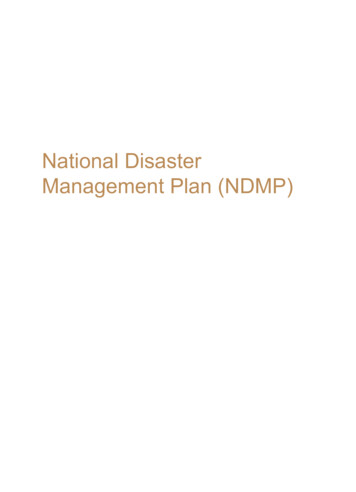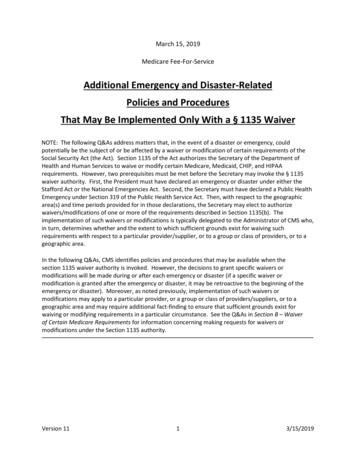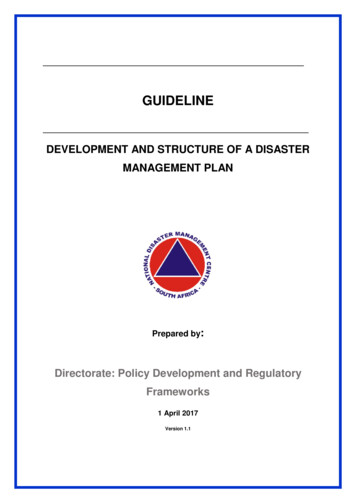
Transcription
GUIDELINEDEVELOPMENT AND STRUCTURE OF A DISASTERMANAGEMENT PLANPrepared by:Directorate: Policy Development and RegulatoryFrameworks1 April 2017Version 1.1
GuidelineDevelopment and Structure of a Disaster Management PlanVersion ControlVersionVersion 1.1File number21/1/1 (Guidelines)Short descriptionGuide the development of a disaster managementplanRelevant toOrgans of state obligated to develop a disastermanagement plan ito the Disaster Management Act,2002AuthorityThis guide has been approved by the Head: NationalDisaster Management Centre in terms of Section19(a) of the Disaster Management Act, 2002.Responsible orksResponsible ChiefPolicy and Legislative ManagementDirectorateDate introduced1 April 2017Date(s) modifiedFirst IssueNext scheduled review date31 March 2019Related documentsSouth African Disaster Risk Management HandbookSeries.Related legislationDisaster Management Act, 2002 (DMA), NationalDisaster Management Framework, 2005 (NDMF,2005)Key wordsGuideline, Disaster Management, National ent Plan, DMP, South African Disaster RiskManagement Handbook Series.Version 1.1 – 1 April 2017Page 2
GuidelineDevelopment and Structure of a Disaster Management PlanAcknowledgementsMany individuals participated in the process to prepare this guideline. Appreciationgoes to all those who have given their time and inputs in this regard. The NationalDisaster Management Centre would specifically like to acknowledge the followingindividuals and organisations for their contributions.Ms Ane BruwerNational Disaster Management CentreMr Jurgens DysselNational Disaster Management CentreMs Prudence DlaminiNational Disaster Management CentreMs Motlalepula PitsoNational Disaster Management CentreMs Benedetta GualandiOXFAMMr William MazibukoCity of JohannesburgMr Moses SitholeWaterberg District MunicipalityDr. Magda LigthelmDepartment of Water and SanitationDr. Ikalafeng KgakatsiDepartment of Agriculture, Forestry andMr David MakateFisheriesMs Sajedah MahomedESKOMMs L Van Den MerweESKOMVersion 1.1 – 1 April 2017Page 3
GuidelineDevelopment and Structure of a Disaster Management PlanContentsList of figures . 5Acronyms . 6Definitions . 7Interrelation / compatibility with other guidelines . 81. Introduction . 92. Purpose of this guideline . 93. Scope . 94. How to use this guideline . 115. Structure of the disaster management plan . 126. Disaster Management Plan Checklist . 186.1 Preface . 186.2 Chapter 1 – Introduction and background . 196.3 Chapter 2 – Constitutional, legislative and policy mandates . 206.4 Chapter 3 – Integrated Institutional Capacity . 216.5 Chapter 4 – Risk Assessment . 236.6 Chapter 5 – Disaster Risk Reduction . 246.7 Chapter 6 – Preparedness planning . 266.8 Chapter 7 – Response . 286.9 Chapter 8 – Recovery . 296.10Chapter 9 – Testing and review of the plan . 296.11Chapter 10 – Contact details and reference documents . 307. Recommendations . 308. Approval . 319. List of References . 32Version 1.1 – 1 April 2017Page 4
GuidelineDevelopment and Structure of a Disaster Management PlanList of figuresFigure 1: Chapter layout of a disaster management plan linked to the NDMF and theattainment of legislative compliance . 14Figure 2: Scope of a level 1 disaster management plan. 15Figure 3: Scope of a level 2 disaster management plan. 16Figure 4: Scope of a level 3 disaster management plan. 17Version 1.1 – 1 April 2017Page 5
GuidelineDevelopment and Structure of a Disaster Management PlanAcronymsDMADisaster Management Act, 2002 (Act No. 57 of 2002)DMHSSouth African Disaster Risk Management Handbook SeriesDMPDisaster Management PlanNDMCNational Disaster Management CentreNDMFNational Disaster Management Framework, 2005Version 1.1 – 1 April 2017Page 6
GuidelineDevelopment and Structure of a Disaster Management PlanDefinitionsThe following words and expressions will, unless the context otherwise requires or theDisaster Management Act, 2002 (Act No. 57 of 2002) or National DisasterManagement Framework, 2005 otherwise provides, have the meanings therebyassigned to them namely―‘Assimilate’, means to take in, absorb and integrate information to fully understandthe context of concepts (Kavanagh, 2002: 65);‘Disaster Management Plan’ means a plan developed by an organ of state in termsof section 25, 38, 39, 52 or 53 of the Disaster Management Act, 2002 (Act No. 57 of2002);‘Integrated development plan’ means a plan envisaged in Section 25 of the LocalGovernment: Municipal Systems Act, 2000 (Act No. 32 of 2000);‘Internalise’ means to make disaster management part of an organs of state’soperations through learning, practicing and assimilation (adapted from Kavanagh,2002: 602);‘Interrogate’, means to ask questions of someone or something closely, or formally,or to obtain data from a computer file, database, storage device, or terminal (adaptedfrom Kavanagh, 2002: 603).Version 1.1 – 1 April 2017Page 7
GuidelineDevelopment and Structure of a Disaster Management PlanInterrelation / compatibility with other guidelinesDuring 2008 the National Disaster Management Centre (NDMC) issued the SouthAfrican Disaster Risk Management Handbook Series1 (DMHS) to assist the provincialand municipal spheres of government with the development of a level 1, level 2 andlevel 3 disaster management plan. The DMHS is a package of handbooks andsupporting materials in the form of guidelines, templates, statutes and otherdocuments for the implementation of disaster management in municipalities andprovinces in South Africa. Drawing from this guidance, this guideline interrelates withthe concepts articulated by the critical outcomes and the related action steps set outin Handbook 1 of the respective DMHS2.This guideline also interrelates with the Guideline for Conducting ComprehensiveDisaster Risk Assessments, Part 1: Hazard Identification, Analysis and Prioritisationissued3 by the NDMC on 25 October 2016.1The DMHS can be downloaded from www.ndmc.gov.zaSee section 5 for more details.3 Government Gazette No. 40393 GN 1363 on 2 November 20162Version 1.1 – 1 April 2017Page 8
GuidelineDevelopment and Structure of a Disaster Management Plan1.IntroductionThe Disaster Management Act, 2002 (Act No. 57 of 2002) (DMA) places a legalobligation4on all organs of state and other institutional role-players involved indisaster management to develop, regularly review, update, coordinate, share andimplement disaster management plans (DMP).The DMA, in Section 15, assigns various powers and duties to the National DisasterManagement Centre (NDMC) which, amongst others, includes not only advisory andconsultative functions, but also, in Section 22, the power to give guidance and adviceto stakeholders with regards to disaster management.2.Purpose of this guidelineThis guideline, developed in terms of Section 19(a) of the DMA and section 3.6 of theNational Disaster Management Framework, 2005 (NDMF) provides a uniformstructure5 and checklist to organs of state to prepare a DMP.3.ScopeThe NDMF states that,“ there is considerable unevenness in disaster risk management planningcapacity and experience, especially across newly established district municipalities,and national and provincial organs of state engaging seriously with disaster risk45See sections 25, 38,39, 52 and 53includes preparation, review and updatingVersion 1.1 – 1 April 2017Page 9
GuidelineDevelopment and Structure of a Disaster Management Planmanagement for the first time will need to undertake careful consultation beforedeveloping a comprehensive disaster risk management plan.To address this wide range of disaster risk management planning capabilities, thenational disaster management framework provides for a phased approach todisaster risk management planning and implementation. It comprises threeprogressive steps from a Level 1 Disaster Risk Management Plan to a Level 3Disaster Risk Management Plan. The completion of each level of disaster riskmanagement plan will yield indicative information about common vulnerabilities incommunities, local areas or provinces. This information should be incorporated intoIDP planning processes and projects.The requirements for each level of disaster risk management plan and the steps tobe taken in developing the different levels are detailed in priority guidelinesdistributed by the NDMC to all stakeholders. The implementation of these plans willform an integral part of the implementation strategy of the Act.” (SA, 2005: 41).Given these requirements, this guideline provides concept guidance to organs of stateto progressively develop a compliant DMP in line with the phased approach putforward by the NDMF. The guideline extracts those key aspects of the four KeyPerformance Indicators (KPA) and three Enablers specified by the NDMF related toDMP’s and arrange6 them into specific chapters, which in turn is linked to the ‘CriticalOutcomes’ and ‘Action Steps’ put forward by the DMHS.It is important to note that the guideline is not intended to be a ‘paint by number’solution nor is it a ‘one size fits all’ approach. Organs of state must thereforeinterrogate, assimilate and internalize the concepts put forward by this guideline, theNDMF and the DMHS to enable them to successfully develop a DMP for their specificfunctional environment.6See figures 1 - 4Version 1.1 – 1 April 2017Page 10
GuidelineDevelopment and Structure of a Disaster Management Plan4.How to use this guidelineThe development of a DMP is not a linear process and requires ongoing commitmentand reflection from an organ of state over a period of time regarding theimplementation of the principles of disaster management in its organisation, to giveaccount of what has already been accomplished in terms of progress made, and reflecton its plan to further the implementation of disaster management in its functional area.Handbook 17 of the DMHS introduces ‘Critical Outcomes’ and ‘Action Steps’ an organof state should consider pursuing to develop a level 1, 2 and 3 DMP. During thisprocess, organs of state must constantly seek to understand and explain: ‘What’ has been accomplished thus far; ‘WHAT’ must be done by the organ of state; ‘WHY’ must it be done by the organ of state; ‘WHO’ from the organ of state must do it; ‘HOW’ must it be done; ‘WHERE’ must it be done; ‘WHEN’ must it be done; and with ‘WHAT’ must it be done.Once these details are known, the organ of state should systematically organise thisinformation and reflect it in its DMP in line with the structure and checklist provided bythis guideline. Given this, the guideline is used in conjunction with Handbook 1 of theDMHS and involves three steps.Step 1: Download the DMHS, DMA and NDMF from the NDMC website.Step 2: Interrogate, assimilate and internalize the concepts.Step 3: Draft the DMP document.7See Handbook 1 for provinces, metropolitan municipalities or district municipalitiesVersion 1.1 – 1 April 2017Page 11
GuidelineDevelopment and Structure of a Disaster Management Plan5.Structure of the disaster management planA DMP must be structured on the one hand to show alignment with the conceptsarticulated by the NDMF whilst on the other hand guarantee legislative compliancewith Sections 25, 38, 39, 52 and 53 of the DMA. Given this, the structure of a DMPmust at least have the following components.a) A preface to provide the preliminary information of the plan.b) Chapter 1: Introduction and background to provide a detailed description ofthe organ of state in relation to disaster management.c) Chapter 2: Constitutional, legislative and policy mandates to provideparticulars of the policy and legal obligation(s) applicable in terms of the DMA,the respective organ of states’ legal mandate and an examination of which riskscould be adequately dealt with within that legislation.d) Chapter 3: Integrated institutional capacity to provide particulars of thecapacity established within the organ of state to enable the effectivedevelopment and implementation of disaster management policy andlegislation.e) Chapter 4: Risk assessment to provide a uniform approach to assessing andmonitoring disaster risks that will inform disaster risk management planning anddisaster risk reduction undertaken the organ of state.f) Chapter 5: Disaster risk reduction to ensure that the organ of state developand implement integrated disaster risk management plans and risk reductionprogrammes in accordance with approved frameworks.g) Chapter 6: Preparedness planning to ensure effective and appropriatepreparedness planning by implementing a uniform approach to thedissemination of early warnings and averting or reducing the potential impactin respect of personal injury, health, loss of life, property, infrastructure,environments and government services through appropriate contingency plans.Version 1.1 – 1 April 2017Page 12
GuidelineDevelopment and Structure of a Disaster Management Planh) Chapter 7: Response to ensure effective and appropriate disaster responseby implementing immediate integrated and appropriate response measureswhen significant events or disasters occur or are threatening to occur.i) Chapter 8: Recovery to ensure effective and appropriate disaster recovery byimplementing all rehabilitation and reconstruction strategies following a disasterin an integrated and developmental manner.a) Chapter 9: Testing and review of the plan to set out the testing and reviewschedule of the plan.b) Chapter 10: Contact details & Reference documents to provide contactdetails and information on the reference material relevant to the plan.Figure 1 shows how the three Enablers and the four KPA’s of the NDMF is linked tothe structure (respective chapters) of a DMP. It also shows how the respectivechapters are linked to promote legislative compliance with Sections 25, 38, 39, 52 and53 of the DMA, as the case may be.Figure 2, shows how the respective chapters of a DMP is linked to the three ‘CriticalOutcomes’ and the respective ‘Action Steps’ listed by the DMHS. By following the‘Action Steps’ the organ of state is guided to progressively develop a level 1 DMP.Figure 3, shows how the respective chapters of a DMP is linked to the four ‘CriticalOutcomes’ and the respective ‘Action Steps’ listed by the DMHS. By following the‘Action Steps’ the organ of state is guided to progressively develop a level 2 DMP.Figure 4, shows how the respective chapters of a DMP is linked to the three ‘CriticalOutcomes’ and the respective ‘Action Steps’ listed by the DMHS. By following the‘Action Steps’ the organ of state is guided to progressively develop a level 3 DMP.Version 1.1 – 1 April 2017Page 13
GuidelineDevelopment and Structure of a Disaster Management PlanS 2 (1)(b) .to the extent that that occurrence can be dealt with effectively in terms of othernational legislation .PrefaceS Xx (1)(c)(i) the way the concept is applied in its functional area.;S Xx (1)(c)(ii) its roles and responsibilities ito NDMF .;Chapter 1:Introduction and BackgroundChapter 2:Policy and Legislative FrameworkEnablersInformation Management &CommunicationEducation, Training, PublicAwareness and ResearchFunding ArrangementsKPA 1:Integrated Institutional CapacityKPA 2:Disaster Risk AssessmentKPA 3:Disaster Risk ReductionKPA 4:Response and RecoveryChapter 3:KPA 1: Integrated Institutional CapacityChapter 4:KPA 2: Risk AssessmentChapter 5:KPA 3: Disaster Risk ReductionChapter 6:KPA 4a: Preparedness PlansChapter 7:KPA 4b: ResponseChapter 8:KPA 4c RecoveryChapter 9:Testing and review of planS Xx (1)(c)(iv) its capacity to fulfil its roles and responsibilities;S Xx (1)(d) .coordinate and allign the implementation of its plan with other organs of stateand institutional role players;S Xx (2) The disaster management plan of an organ of state referred to in subsection (1)must form an integral part of its planning;S 53 (1)(h).consult the local community on the preparation or amendment of its plan.S Xx (1)(a) .conduct a disaster risk assessment for its functional area;S Xx (1)(b) .identify and map risks, area, ecosystems.;S Xx (1)(c)(v) particulars of its disaster management strategies.;S Xx (1)(e) .invest in DRR and climate change adaptation .;S Xx (1)(f) develop early warning mechanisms and procedures .;S Xx (1)(c)(iii) its roles and responsibilities regarding emergency response .;S Xx (1)(c)(vi) contingency strategies and emergency procedures .;S Xx (1)(c)(vii) spesific measure taken to adress the needs of woman,;S Xx (1)(g) regularly review and update the plan.;Chapter 10:Contact details & Reference DocumentsFigure 1: Chapter layout of a disaster management plan linked to the NDMF and the attainment of legislative complianceVersion 1.1 – 1 April 2017Page 14
GuidelineDevelopment and Structure of a Disaster Management PlanPrefaceLEVEL 1 PLANA Level 1 Disaster Risk Management Plan focuses primarily on establishingfoundation institutional arrangements for disaster risk management, putting inplace contingency plans for responding to known priority threats as identifiedin the initial stages of the disaster risk assessment, identifying keygovernmental and other stakeholders, and developing the capability togenerate a Level 2 Disaster Risk Management Plan.Chapter 1:Introduction and BackgroundEnablersInformation Management &CommunicationEducation, Training, PublicAwareness and ResearchFunding ArrangementsKPA 1:Integrated Institutional CapacityKPA 2:Disaster Risk AssessmentKPA 3:Disaster Risk ReductionKPA 4:Response and RecoveryChapter 2:Policy and Legislative FrameworkCritical Outcome 1: Establish Foundational InstitutionalArrangements for Disaster Management10 Action StepsChapter 3:KPA 1: Integrated Institutional CapacityCritical Outcome 2: Develop the Capability to generate aLevel 2 Disaster Management Plan8 Action StepsChapter 4:KPA 2: Risk AssessmentChapter 5:KPA 3: Disaster Risk ReductionChapter 6:KPA 4a: Preparedness PlansCritical Outcome 3: Develop and implement contingencyplans for known priority risks8 Action StepsChapter 7:KPA 4b: ResponseChapter 8:KPA 4c RecoveryChapter 9:Testing and review of planChapter 10:Contact details & Reference DocumentsFigure 2: Scope of a level 1 disaster management planVersion 1.1 – 1 April 2017Page 15
GuidelineDevelopment and Structure of a Disaster Management PlanLEVEL 2 PLANA Level 2 Disaster Risk Management Plan focuses establishing processes fora comprehensive disaster risk assessment, identifying and establishing formalconsultative mechanisms for development of disaster risk reduction projectsand introducing supportive information management and communicationsystem and emergency communications capabilities.PrefaceChapter 1:Introduction and BackgroundChapter 2:Policy and Legislative FrameworkEnablersInformation Management &CommunicationEducation, Training, PublicAwareness and ResearchFunding ArrangementsKPA 1:Integrated Institutional CapacityKPA 2:Disaster Risk AssessmentKPA 3:Disaster Risk ReductionKPA 4:Response and RecoveryChapter 3:KPA 1: Integrated Institutional CapacityChapter 4:KPA 2: Risk AssessmentChapter 5:KPA 3: Disaster Risk ReductionChapter 6:KPA 4a: Preparedness PlansChapter 7:KPA 4b: ResponseCritical Outcome 1: Establish processes forcomprehensive disaster risk assessments4 Action StepsCritical Outcome 2: Identify and establish formalconsultative mechanisms for specific priority riskreduction projects6 Action StepsCritical Outcome 3: Develop a Supportive informationmanagement system7 Action StepsCritical Outcome 4: Develop EmergencyCommunication Capabilities9 Action StepsChapter 8:KPA 4c RecoveryChapter 9:Testing and review of planChapter 10:Contact details & Reference DocumentsFigure 3: Scope of a level 2 disaster management planVersion 1.1 – 1 April 2017Page 16
GuidelineDevelopment and Structure of a Disaster Management PlanPrefaceLEVEL 3 PLANA Level 3 Disaster Risk Management Plan specifIes clear institutionalarrangements for co-ordinating and aligning the plan with other governmentalinitiatives and plans of institutional role players. It must also show evidence ofinformed disaster risk assessment and ongoing disaster risk monitoringcapabilities as well as relevant developmental measures that reduce thevulnerability of disaster-prone areas, communities and households.Chapter 1:Introduction and BackgroundChapter 2:Policy and Legislative FrameworkEnablersInformation Management &CommunicationEducation, Training, PublicAwareness and ResearchFunding ArrangementsKPA 1:Integrated Institutional CapacityKPA 2:Disaster Risk AssessmentKPA 3:Disaster Risk ReductionKPA 4:Response and RecoveryChapter 3:KPA 1: Integrated Institutional CapacityCritical Outcome 1: Establish specific institutionalarrangements for coordinating and aligning plans8 Action StepsChapter 4:KPA 2: Risk AssessmentCritical Outcome 2: Establish mechanisms to ensureinformed and ongoing risk assessments5 Action StepsChapter 5:KPA 3: Disaster Risk ReductionCritical Outcome 3: Implement mechanisms to ensurethe relevance of disaster management plans andframeworks8 Action StepsChapter 6:KPA 4a: Preparedness PlansChapter 7:KPA 4b: ResponseChapter 8:KPA 4c RecoveryChapter 9:Testing and review of planChapter 10:Contact details & Reference DocumentsFigure 4: Scope of a level 3 disaster management planVersion 1.1 – 1 April 2017Page 17
GuidelineDevelopment and Structure of a Disaster Management Plan6.Disaster Management Plan ChecklistThe checklist content provided below is drawn, where applicable, from the principlesset out in the NDMF.6.1PrefaceThis chapter of the DMP provides the preliminary information of the plan and shouldaddress at least the following items.a)The front page listing the,i.name of the organ of state.ii.logo of the organ of state.iii.name of the plan.iv.version of the plan.v.date the plan was approved by the executive authority8.vi.the document classification grading9 assigned to the plan by theaccountable officer.b)c)The ‘in page(s)’ listing the,i.developer’s name(s).ii.acknowledgements.iii.approval of the plan.The foreword page(s) listing,i.why the plan is developed.ii.the purpose of the plan.8The Minister, MEC or Council as the case may be.In terms of the Minimum Information Security Standards (MISS) adopted by Cabinet, the assignmentof a classification grade rests with the institution where the document(s) have their origin. Whilst DMP’sshould not be assigned a classification grade, in cases where such a classification is made, suchclassification must be indicated in the header of each page of the DMP.9Version 1.1 – 1 April 2017Page 18
GuidelineDevelopment and Structure of a Disaster Management Planiii.a statement of commitment by the Head of Department or ChiefExecutive Officer as the case may be.d)The executive summary page(s).e)The contents page(s).f)A list of figures (and or tables) page(s).g)An acronyms page(s).h)The definitions page(s).i)The distribution page listing the organisations and date(s) to which the plan wasdistributed.6.2Chapter 1 – Introduction and backgroundThis chapter of the DMP should provide a detailed description of the organ of state inrelation to disaster management and must address at least the following items.a)Describe the organ of state including but not limited to the,i.Geographical profile including a map of the area.ii.Demographic profile.iii.Environmental profile.iv.Socio/economic profile.b)Describe the disaster incident history, its impact and geographical location(s).c)Describe the infrastructure / critical facilities within the area of the organ of stateor owned by the organ of state providing or supporting (basic) services.d)Briefly explain the methodology used to develop the plan including how data wascollected, which literature sources were used etc.e)Describe which stakeholders were consulted.Version 1.1 – 1 April 2017Page 19
GuidelineDevelopment and Structure of a Disaster Management Plan6.3Chapter 2 – Constitutional, legislative and policy mandatesThis chapter should provide particulars of the policy and legal obligation(s) applicablein terms the respective organ of states’ legal mandate and an examination of whichdisasters could be adequately dealt with, within that legislative mandate before theapplication10 of the DMA becomes relevant. The Chapter must address at least thefollowing concepts.a)Constitutionali.State and explain the applicable constitutional authority to performduties.b)Legislativei.State the assigned legislative source of authority to perform duties.i.List and summarise the legislation applicable to the particular organ ofstate.ii.Provide a list of Acts which effectively can deal with disasters effectivelyoutside of the DMA.iii.Explain the organ of states’ legislative framework and fundingarrangements to deal with disasters.c)Policyi.List and summarise the applicable policy11 for the particular organ ofstate.10See Section 2 (Application of the Act) of the DMANational, provincial and local policy as well as internal policy of the organ of state as it relates todisasters11Version 1.1 – 1 April 2017Page 20
GuidelineDevelopment and Structure of a Disaster Management Plan6.4Chapter 3 – Integrated Institutional CapacityThis chapter should provide particulars of the capacity established within the organ ofstate to enable the effective development and implementation of disaster managementpolicy and legislation and must address at least the following items (SA, 2005: 4).a)Organ of state organisation.i.Provide the organisational hierarchy and explain the roles andresponsibilities of the relevant functional units ito disaster management.ii.Discuss and explain the functioning and participation in intra- and interdepartmental committees.iii.Explain linkages and coordination with other stakeholders.iv.Discuss joint decision making as it relates to disaster management,identify the gate keepers of key information, resources etc.b)Arrangements for the development and adoption of integrated disaster riskmanagement policy.i.Explain the relationship of the organ of state to the executive authority12as it relates to disaster management.c)Arrangements for integrated direction and implementation of disaster riskmanagement policy.i.List the key responsibilities of the organ of state in terms of its applicablelegislation, the DMA and the NDMF.ii.Discuss the institutional capacity of the organ of state to fulfil its rolesand responsibilities in terms of its applicable legislation, the DMA and theNDMF.iii.Discuss the disaster management focal point and its assignedresponsibilities.12The ICDM, Legislature or Council as the case may beVersion 1.1 – 1 April 2017Page 21
GuidelineDevelopment and Structure of a Disaster Management Planiv.Explain the rationale for the location of disaster management function 13in the organisational structure.d)Arrangement for stakeholder participation and the engagement of technicaladvice in disaster risk management planning and operations.i.Discuss the establishment, functioning and or participation in the disastermanagement advisory forum(s).ii.Discuss the mechanism to ensure integrated and coordinated disastermanagement planning.iii.Discuss the institutional arrangements to ensure the participation ofvolunteers (where applicable).iv.Discuss the institutional arrangements to consult communities andstakeholders.e)Arrangement for national, regional and international co-operation for disaster riskmanagement.i.Discuss how cooperative governance is promoted through the ICDM,advisory forums, etc.ii.Discuss the mechanism and agreements to share expertise andresources.iii.List mutual assistance agreements arrangements applicable to the organof state.iv.Discuss regional and international cooperation arrangements applicableto the organ of state.f)Explain how information management and communication systems areestablished in line with section 5.4.1 of the NDMF and is used by the org
Guideline Development and Structure of a Disaster Management Plan Version 1.1 - 1 April 2017 Page 2 Version Control Version Version 1.1 File number 21/1/1 (Guidelines) Short description Guide the development of a disaster management plan Relevant to Organs of state obligated to develop a disaster management plan ito the Disaster Management Act,



